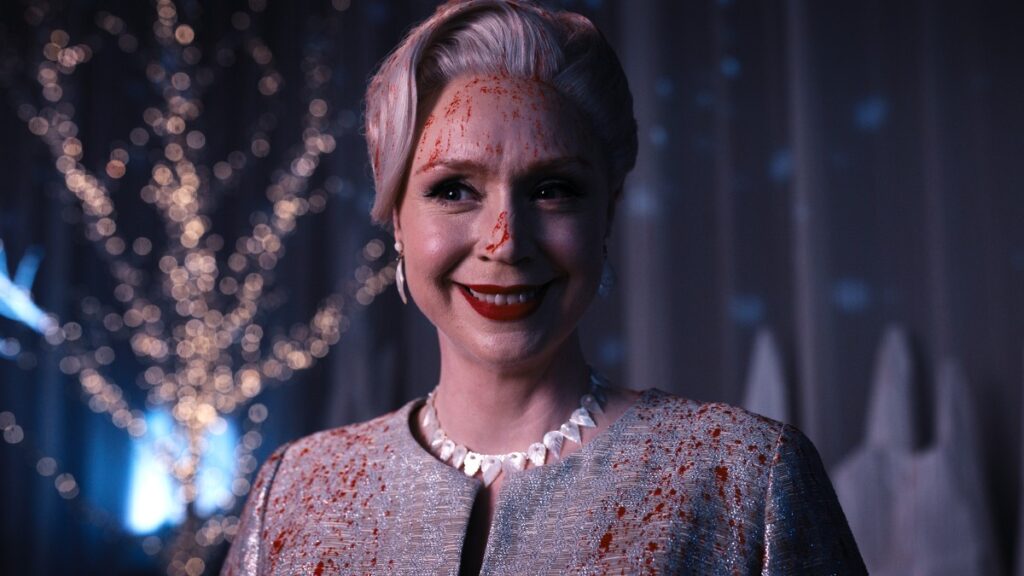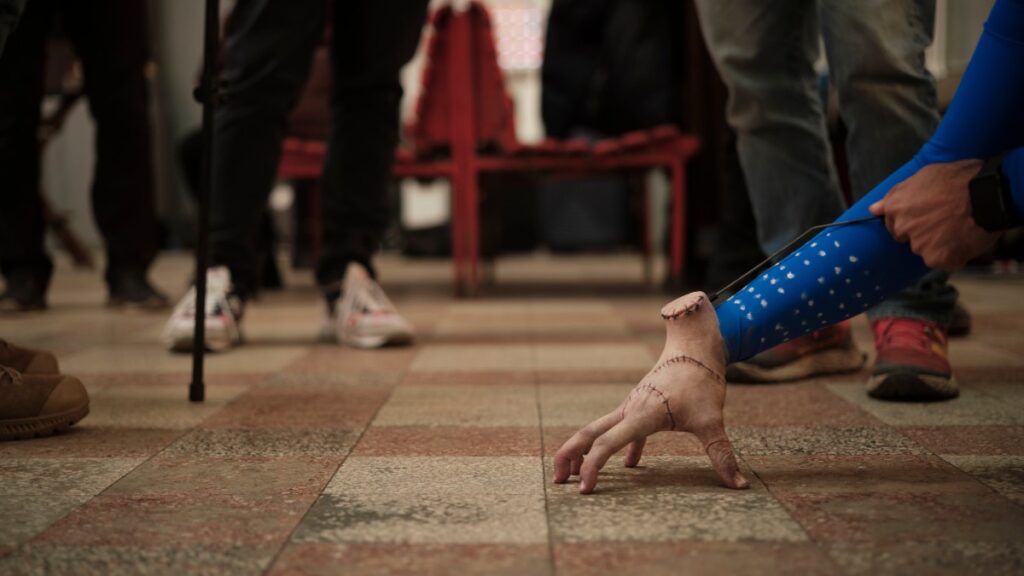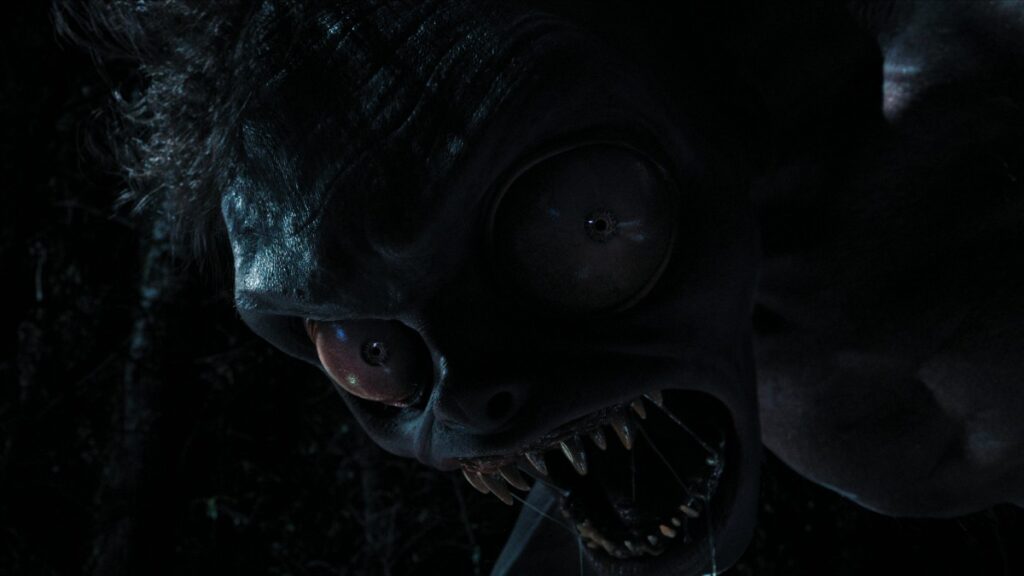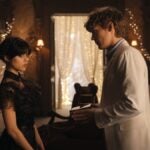
Spoiler alert: The following article discusses the entirety of Netflix’s “Wednesday.”
In the spring of 2019, “Smallville” creators Al Gough and Miles Millar conjured the idea for what would eventually become Netflix’s fantastical hit “Wednesday.” The pitch, which began as a six-word long concept centering on an adolescent version of the sardonic Addams family offspring, kicked off a three-year process that would culminate in an eight-month-long shoot on-location in Romania, featuring Tim Burton’s first foray into TV in 30 years and a star-making turn by lead Jenna Ortega.
After tracking down the adaptation rights-holders at MGM (which released the 2019 animated “The Addams Family”), the company — under then-head of scripted television Steve Stark — agreed to finance the writers room as the duo pitched the series.
“We say in typical Wednesday Addams fashion that we had probably one of the first Zoom rooms because our room started the week of lockdown,” Gough said. “We did a 10 week writers room, I’d already had a full Bible, and we’d already written the first episode.”
While the initial pitch included the setting of Nevermore Academy, a mythical boarding school filled with outcasts like goblins and vampires, Millar said the pair “wrestled” with the concept, wondering if it would be “too ‘Harry Potter’ or too Hogwarts,” before settling on the idea that the locale would provide a “gothic space” for the Addams family sire without her relatives in the picture.
Throughout the decades, the singular, off-kilter clan has been depicted numerous times following Charles Addams’ original 1938 New Yorker illustrations, which served as the inspiration for the Netflix show and subverted the idea of the traditional nuclear family. Even after the beloved 1991 film starring Christina Ricci as Wednesday, “The Addams Family” musical based on the Broadway phenomenon is the No. 1-produced high school musical nationwide and has been for nearly a decade — a fact that eluded even Gough and Millar.
“It’s a smorgasbord of tones: it’s funny, it’s sad, it’s emotional, some horror elements, spooky and kooky and all the things that you love about the Addams family, but I think elevated for a new generation,” Millar told TheWrap. “It has an edge to it, lots of real emotion. I think people will be surprised at the end of the eight episodes that they feel the emotional impact of the characters and what happens to them, and that was certainly our aim to add complexity to the situation. What would it really be like Wednesday? She’s a very difficult character to deal with in terms of the modern world, and how does she respond to different people? She’s always been around her family, so to put her somewhere else felt like we were adding something to the lore of the Addams family.”
Burton, who executive produced and directed four episodes, was always the “first choice” for the duo. A year after the initial concept was born, Gough and Millar sent four scripts to Burton’s agent, who liked it and sent it over to him.
“So suddenly, we were on a FaceTime with Tim Burton, and he was out in his garden with the dinosaur topiary behind him, very, very on brand for Tim,” Gough recalled. “He goes, ‘I read the script, it really spoke to me, I would have dated Wednesday Adams in high school’ — we just got him at the right time. And he committed on the spot.”
Even though Burton only had a directing role with half the series, he was in Bucharest during the entire shoot, with the duo describing him as “very active” and “involved” with the project.
“People have approached Burton about the Addams Family before, but he said it was always too cartoony and too based on sight gags for him,” Gough explained of the Oscar-nominated “Edward Scissorhands” filmmaker.
Once Burton signed onto the project, he brought along with him frequent collaborators and veterans in their respective fields, costume designer Colleen Atwood and composer Danny Elfman, whose work was supplemented by a full orchestra in Bucharest.
“It was just a lot of fun, getting a call, and the fact that it’s Charles Addams-inspired — I already knew it was just going to be really fun and second-nature to me and so much a part of my own life,” Elfman told TheWrap.
That excitement — of getting involved with the series’ making — is something cast member Gwendoline Christie understands dearly.

“One day I was on a walk in the countryside with some friends and I got a text saying, Tim Burton would like to speak to you about his new project. And it’s the Addams Family. And my heart just exploded with complete and utter joy because I wanted to work with Tim Burton my entire life,” she said. “What Tim does so brilliantly, is that he explores and celebrates the outsider, but also illuminates it with real humanity. And I think he’s one of our truly great auteurs that has managed to also achieve this enormous, mainstream success because what he’s managed to translate are some of the universal themes of what connects us as human beings, and also delights us with a dazzling and blisteringly original visual sense. So I was over the moon.”
Shooting on location in Romania allowed the country’s neo-gothic architecture to permeate into and influence the show’s world, with the Carpathian Mountains and Peleș Castle (which inspired the castle in “Dracula”) serving as a backdrop to the Addams family reimagining. At the same time, everything — including the sprawling Nevermore — was built from scratch inside a studio.
“The best part about it was that — it sounds bad at first — we were all alone,” Hunter Doohan (who plays Tyler) said, laughing. “But then we all got to bond with our cast so quickly because it was like, ‘Oh, I don’t know a single soul in this city.’”
Luis Guzmán, who portrays a new version of the ever-passionate Gomez Addams, had a different take on the shoot: “I got pissed off when I found out that the story takes place in Vermont — I live in Vermont! We could have shot this in Vermont? Are you kidding me? But no, Romania was great,” he joked.
The actor echoed other cast members’ jubilee at the shoot, saying, “I welcome the opportunity to be part of this kooky family … I’m not gonna lie to you, I’m like a kid in a candy store showing up to work every day, it’s beautiful — putting on the costume, putting on that wig, you couldn’t ask for anything more.”
When it came time to craft the visual and sensory details of the series, the process was akin to the show’s central tenets — of being both a retelling and an homage of sorts to the various generations of the Addams family that had come before it.
“She begins as Wednesday in an American school, with her typical Wednesday dress where she stood out amongst all the kids and their hipster, American colors, and then she goes to Nevermore and the second she gets [there], she gets the uniform that’s her special uniform,” Atwood said, describing the approach to costuming. “So immediately you’re in a new world with her. Her off-duty and her casual clothes became a big part of the story — running around, doing stuff — so we could incorporate contemporary fashion.”
The Oscar-winning “Chicago” designer continued, “Jenna’s take on the character was so strong, she was so sure of who Wednesday was from the start, that in the fittings it just flowed that way.”
Costume design also played an important role in the depiction of other characters, like the iconic Morticia Addams (played by Catherine Zeta-Jones), whose signature plunging black dress Atwood was thrilled to reinvent for the modern world. The same was true for the creation of Christie’s Larissa Weems, the principal at Nevermore Academy, whose persona and appearance was heavily influenced by an old poster Atwood had of Alfred Hitchcok’s “The Birds,” featuring a woman with a high collar and an updo.
“What she does is close to witchcraft, because she can totally transform the body,” Christie said of Atwood, whom she called a “legend.” “She’s also one of the most collaborative costume designers I’ve ever worked with, which I was really overwhelmed by. It was such a privilege. She wanted to know what I thought. She has a range of references I have never seen before that are entirely appropriate and completely specific and sometimes obscure … She made me feel beautiful, and she really worked with my best assets and in carving this character physically and her appearance … and I’ve never felt beautiful on screen before.”
That attention to detailing was also reciprocated by Christie, who originated the idea of adorning her character with “surrealist” haute jewelry by Schiaparelli, whose designer, Daniel Roseberry, the “Game of Thrones” alumna is friends with.
“We have a bracelet covered in eyes and so I liked the idea of those being active and always watching,” she explained. “And so no matter where she was, Larissa had a 360 degree view of what was going on. But also Larissa wears a Gemini necklace very often, which of course is duality and the twins and so we have that duality captured in the necklace piece that she wears by Schiaparelli, so Larissa’s shapeshifting and dual sense is always hiding in plain sight.”
Sonically, it was about taking elements of the seminal Addams family tune and creating “almost like an alternate universe, side part,” Elfman said. “We had to give it its own tonality with the music, but every now and then, we just applied a little snap-snap because that original theme is so great, but it makes it the easiest theme to go ‘There it is.’”

Another standout element of “Wednesday” is, of course, Thing, crafted and played by Victor Dorbobantu, a former magician. The artist began the process “from zero,” building the strange helper’s look with the VFX team and improvising a form of sign language that enabled the severed hand to communicate and gesticulate.
“Everybody tried to make this character look natural and human,” he told TheWrap. “I tried to find anything with hands. I studied all the work of Christopher Hart, [who played Thing in the ‘90s films]. I documented everything, I saw all the movies that contain hands and cut hands, even zombie movies. I tried to take a little bit from each one.”
When it came down to the grand finale, the reveal of Tyler as the malicious, easily manipulated Hyde, the look of the monster is entirely Burtonian, Millar said.
“He called us one afternoon for a monster conference, he’d actually done a bunch of sketches. And he had this one watercolor, and it was awesome,” Millar explained. “It was the silhouette of the actual monster in the show. And he’d done it. He’d been up all night painting this little thing and that’s basically what it became.”

Naturally, there is no talking about “Wednesday” without its title character, whom Ortega brought to life as a teenager for the first time. The “Scream 5” actress previously discussed the difficulty of nailing down the character — someone who exhibits little emotion but must grow even in incremental ways to make her a compelling protagonist to root for. It was a gargantuan task for anyone, and was further complicated by an isolated shoot in a country feeling the effects of the war in Ukraine and a bout of COVID.
“She brought an intensity and intelligence to it,” Gough said in praise of Ortega. “We were all trying to make sure that Wednesday was always Wednesday … that she didn’t turn into Nancy Drew.”
At the very end of the show’s eight episodes, Wednesday exhibits a “tiny” character arc — when she hugs her roommate Enid (Emma Myers); it was essential for Millar that the persona wasn’t “softened” during the series’ unfolding.
“It was insane, and the show was huge,” Millar said. “It was overwhelming … It was a very hard shoot.”
Gough added, “But she was a total trooper and really stepped up and I think she’s phenomenal.”
Drew Taylor contributed to this report.


















